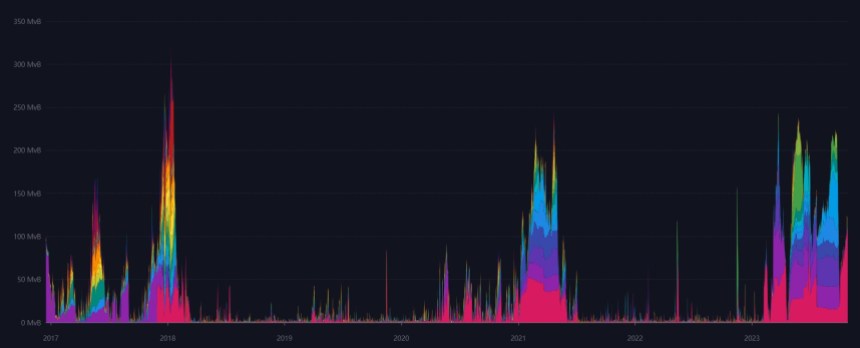Bitcoin price stands firm around the critical $34,000 area, indicating further upside potential. However, market analysts are wondering whether there is enough evidence to point to the upside or whether Bitcoin will return to the $20,000 level.
As of this writing, Bitcoin is trading at $34,150 with sideways movement over the past 24 hours. The cryptocurrency posted a 15% gain in the previous week and remains the best-performing coin by market cap.
Bitcoin on-chain activity rises, indicating a bullish rally?
Data from analytics platform mempool.space shows an increase in on-chain activity on the Bitcoin network. This spike occurred in February 2023, when Bitcoin transactions rose above 50 virtual megabytes (MvB).
According to the analytics platform, the above metric measures the volume of transactions and blocks on the BTC network. The larger the transaction, the more space is required.
As shown in the chart below, every time the price of Bitcoin rises, there is an increase in activity that triggers the rise. This happened in 2017 and 2021, and is happening this year, indicating that the ecosystem is thriving, accommodating more users, and preparing for a more significant rise as it did the previous year.



In addition to increased activity, it is possible to see a decline in the gauge during bear markets and bull markets conclude with higher activity. In contrast, a bear market has much less user activity and is generally cheaper to trade.
However, unlike 2017 and 2021, this year saw the implementation of non-fungible tokens (NFTs) and new applications that leverage these metrics. Thus, it is difficult to say whether the current rally can reach similar levels than in previous years, as the BTC DeFi ecosystem attracts more users looking to leverage the network for benefit rather than long-term investment.
Does BTC DeFi make a difference to the main BTC meter? A chat with the team behind ‘Skin’
The rise in BTC chain activity can be attributed to the cyclical nature of the cryptocurrency market. When the price of Bitcoin etc. rises, or there is an expectation of more profits, more users join the network.
As a result, the number of recorded transactions increased. However, many believe that with the implementation of NFTs in the BTC ecosystem, transaction activity can no longer be attributed to a new bull cycle.
If so, increased activity metrics may become useless when measuring the sustainability of Bitcoin’s rise. To answer this question, we spoke with Mark Hendrickson, managing director of Trust Machines, a company working on a Bitcoin DeFi wallet. This is what he told us:
What is a “skin,” and what is your goal in the Bitcoin ecosystem?
A: Skins are Web3 wallets built on Bitcoin-based technologies and applications. So you can think of Leather, simply put it as MetaMask for Bitcoin, in the sense that we want to provide a robust user experience for connecting to applications built with Bitcoin and Bitcoin layers in which users can do a lot of the same kind of things that they can only do concurrently on L1 chains. enabled smart contracts, but they can actually do it on Bitcoin.
So, Leather has the ability to connect applications, identify yourself to those applications based on your Bitcoin addresses and the assets associated with those applications that claim signed transactions that are essentially actions of those applications and do that across layers. (…) We also want to facilitate the movement of liquidity between L1 and L2 (networks) and do it in a very smooth way.
Many people, for many reasons, are not familiar with the Bitcoin DeFi ecosystem. Can you tell us more about it, and what Leather’s role is in it? Also, what would you say to users who want Bitcoin to remain unchanged, as it has been since its inception in 2009?
A: Bitcoin-based DeFi, I think it’s generally happening these days or kind of popping up in a couple of places. You have the basics of Bitcoin-based sharding on Bitcoin itself. It’s L1 (Layer 1), mostly driven by Ordinals and within Ordinals fungible token standards like BRC 20. Then you also have the Bitcoin stuff that happens on Layer2 like Stacks that have smart contract functionality. (…) Most of this happens through ordinal arrangements over classes. This is mostly done through the native smart contracting capabilities of those layers.
As for the question of people who want Bitcoin to remain unchanged, I think people who work on Bitcoin-related jobs, I would say Bitcoin web3 in general, which includes DeFi. We’re actually trying to do more with Bitcoin without having to change Bitcoin at all. So our general approach is actually to try to expand what you can do with Bitcoin without having to fundamentally change it because, of course, we want to respect all the work that’s been done in Bitcoin so far and we like the security profile of Bitcoin. This has to do with taking a relatively conservative approach. So, if you look at ordinals, for example, which is actually an innovation based on the radical that was introduced fairly recently, there’s a lot of innovation going on as a result of the radical without changing anything else about Bitcoin. It’s a design space that fully respects Bitcoin as much as blockchain.
There is a theory that each bull run is preceded by a surge in on-chain activity, with fees tracking prices on their way to new highs. What do you think of the network activity now? Do you think a lot of it can now be attributed to other arrangements and applications?
A: Going back to the beginning of the year, Ordinals was a big exception to the general rule of a bear crypto market because we basically saw two bull runs within the Ordinals itself, which I think strengthened Bitcoin’s position and certainly boosted the network activity on Bitcoin and fee prices went up as a result. And it really showed that the idea of storing data on a chain on Bitcoin goes beyond just simple transactions and applying those primitives to different web3 applications, whether they’re technical or whether they’re new token standards, can have a huge impact on how Bitcoin is used and also the value. (…) It’s difficult for me to pinpoint any specific reason why the price of Bitcoin in any given month might rise due to other factors, but it’s very clear that it has a general effect (on network activity). Ordinal had a positive impact on interest in Bitcoin.
ETFs, Store of Value, Gold 2.0, Halving, and now Bitcoin DeFi, what is the current narrative dominating the BTC market? Which narrative will matter more in the long term?
A: I think the prevailing narrative around Bitcoin is probably that in the wake of the recent crash, it was actually a spillover from last year. I think there were a lot of weaker technologies and weaker platforms and assets that got dumped and people ran away from them and took a safer haven and Bitcoin came back to Bitcoin being the currency that has stood the test of time. So, combined with the fact that people, since the beginning of the year with Ordinals in particular, have opened up that there are more limits to what you can do with Bitcoin. I think this combination has actually led to a kind of renewed enthusiasm around Bitcoin. It’s a combination of, it’s been around the longest, it’s the safest, plus it’s not a dinosaur that couldn’t evolve. It actually has a lot of potential. It actually has both those attractive, safe and conservative qualities in one way, but it’s also more innovative and has more potential than people ever realized before in the other.
Cover image from Unsplash, chart from Tradingview
